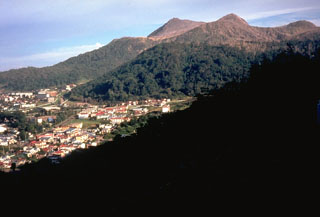Report on Toya (Japan) — March 1978
Scientific Event Alert Network Bulletin, vol. 3, no. 3 (March 1978)
Managing Editor: David Squires.
Toya (Japan) Two small eruptions in late February; cryptodome uplift and seismicity increase
Please cite this report as:
Global Volcanism Program, 1978. Report on Toya (Japan) (Squires, D., ed.). Scientific Event Alert Network Bulletin, 3:3. Smithsonian Institution. https://doi.org/10.5479/si.GVP.SEAN197803-285030
Toya
Japan
42.544°N, 140.839°E; summit elev. 733 m
All times are local (unless otherwise noted)
Two small eruptions were observed during February, originating from vents 250-300 m ENE of the summit of Ko-Usu dome. The first occurred at 1559 on the 25th from a vent 2-3 m in diameter, producing a 500-m gray ash cloud and a trace of ashfall near the volcano. The dark gray ash cloud from the second eruption, at 0740 on 27 February, rose about 1,200 m from a 15-20-m-diameter crater, causing 2-3 mm of ashfall a few km SE of Usu.
The rate of uplift at the . . . cryptodome increased substantially, from about 23 cm/day in January to about 39 cm/day in February at Ogari-yama, and from 26 cm/day in late January to about 41 cm/day in February at the unnamed [peak] about 400 m E of the summit of Ko-Usu. February subsidence at Ko-Usu continued at the January rate of about 8 cm/day. Daily earthquake counts at Usu began to increase in late January and remained relatively high through most of February (figure 9).
 |
Figure 9. Number of seismic events/day during l December 1977-28 February 1978, recorded by a JMA seismograph 2.3 km N of the summit of O-Usu. Arrows mark steam explosions. Courtesy of JMA. |
Geological Summary. Usuzan, one of Hokkaido's most well-known volcanoes, is a small stratovolcano located astride the southern topographic rim of the 110,000-year-old Toya caldera. The center of the 10-km-wide, lake-filled caldera contains Nakajima, a group of forested Pleistocene andesitic lava domes. The summit of the basaltic-to-andesitic edifice of Usu is cut by a somma formed about 20-30,000 years ago when collapse of the volcano produced a debris avalanche that reached the sea. Dacitic domes erupted along two NW-SE-trending lines fill and flank the summit caldera. Three of these domes, O-Usu, Ko-Usu and Showashinzan, along with seven crypto-domes, were erupted during historical time. The 1663 eruption of Usu was one of the largest in Hokkaido during historical time. The war-time growth of Showashinzan from 1943-45 was painstakingly documented by the local postmaster, who created the first detailed record of growth of a lava dome.
Information Contacts: JMA, Tokyo; T. Tiba, National Science Museum, Tokyo.

